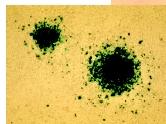Gene Therapy
Gene therapy is an experimental disease treatment in which a gene is delivered to cells in the body. The protein made by the new gene compensates for the absence of normal proteins or interacts with some abnormal protein already in the cell to interrupt its function. Gene therapy is not yet a routine treatment for any disease, but it may become so as researchers solve the many technical problems it presents.
Humans are prey to numerous diseases due to single-gene defects, such as adenosine deaminase deficiency (defective enzyme ), cystic fibrosis (defective ion channel), and Duchenne muscular dystrophy (defective muscle protein). Replacement of the defective gene is conceptually simple, but practically very difficult. Effective gene therapy requires delivering the gene to each cell in which it acts, integrating the gene with the thousands of others on the chromosomes and regulating the expression of the gene.
Gene delivery is a major hurdle. Viruses are the most commonly used vehicle, or vector , since they have been designed by evolution to deliver their own genes to our cells. Adenovirus (a type of cold virus) has been the most commonly used vector, since it can carry a very large gene and will infect most cell types. However, the immune system is designed to prevent this type of infection, and immune rejection has so far thwarted most gene therapy efforts. While most patients have not been harmed by this problem, one gene therapy patient has died from immune response to the adenovirus. Modifications of the virus, using fewer immunogenic viruses (such as adeno-associated virus, herpes virus, or retrovirus), immune-suppressive drugs, and nonviral delivery systems are all possible solutions. Curiously, the brain does not mount a strong immune response, and as such, represents a promising site for gene delivery in neurological diseases.

Getting the gene to enough target cells is also a significant challenge. Adenosine deaminase deficiency affects white blood cells and causes severe combined immune deficiency ("bubble boy" disease). This disease can be treated by removing white blood cells, inserting the adenosine deaminase gene into them, and returning the cells to the bone marrow. Cystic fibrosis presents a much bigger challenge, since it affects the airways and pancreas. Inhalation of the vector may treat the lungs, but the pancreas is more difficult to reach without injecting vector into the bloodstream. Duchenne muscular dystrophy is an even bigger challenge, since it affects all muscles, and muscles make up 45 percent of the body. The only realistic treatment option in this case is systemic delivery, which poses the added challenge of preventing delivery to nonmuscle tissue.
Once inside the target tissue, genes usually become active whether or not they are integrated into the host chromosome. However, long-term expression requires that the gene join the host chromosome. Directing the gene to do so, and to integrate in a way that doesn't disrupt other genes, is still a significant challenge. Regulating its expression, so that enough of the protein (but not too much) is made, is also a problem. Currently, most virally delivered genes do not integrate successfully, and stop making protein after several weeks to months.
While correction of gene defects was the original inspiration for gene therapy research, treatment of other diseases is now being explored. Cancers are an appealing target, and several strategies are possible. Currently the most promising is delivering a so-called "suicide gene," whose protein product renders a tumor more sensitive to cell-killing drugs, allowing lower doses of chemotherapy to be effective. This works well for solid tumors, which can be injected with the gene. Delivery to more diffuse locations is still problematic. Further research on cellular properties of cancer cells may broaden the reach of this and similar cancer-targeting strategies.
SEE ALSO Chromosome, Eukaryotic ; Crick, Francis ; Gene ; Genetic Diseases ; Mendel, Gregor ; Recombinant DNA
Richard Robinson
Bibliography
Lemoine, N. R. Understanding Gene Therapy. Oxford: BIOS Scientific Publishers, 1999.
Lewis, Ricki. Human Genetics: Concepts and Applications, 4th ed. New York: McGraw-Hill, 2001.
Stolberg, Sheryl Gay. "The Biotech Death of Jesse Gelsinger." New York Times Magazine (28 November 1999): 17.
Comment about this article, ask questions, or add new information about this topic: